Things to do in Luang Prabang
Luang Prabang's historic temple complexes are its main attractions, with many considering Wat Xieng Thong (Golden City Temple) to be the most magnificent of them all. The nearby Royal Palace is another popular stop. Now a museum, its golden-spired stupa is one of the country's most iconic images. Visitors also enjoy Wat Wisunalat, which is the oldest continually operating temple in the city. Mount Phu Si sits across the river and has several temples on its slopes. The monastery on its summit is well-loved for its dazzling sunset views of the town's gilded spires.
Otherwise, visitors typically delight in wandering through the picturesque district, watching life unfold on the riverbanks, shopping in the bustling markets and giving alms to monks. Early risers can enjoy an authentic slice of Laotian life by purchasing fresh produce near the Mekong River at Ban Pakam Market. The Night Market opens at dusk near Wat Mai and is a great way to end a day of exploring.
On the culinary front, visitors will find a variety of quality restaurants. The city's menu ranges from traditional Laotian food to steaks, stews and baguettes. Vegetarians will do well. Culturally speaking, Luang Prabang's restaurant scene retains a clear French influence. Foodies will find French and French-fusion establishments, as well as glorious little bakeries that have a distinctly Parisian feel.
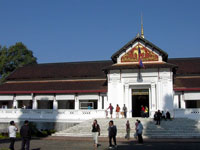
Royal Palace (Haw Kham)
The former Royal Palace is a mixture of French and Lao architecture. It preserves the monarchy's possessions and has an extremely opulent interior, with the Throne Room being the m…
Royal Palace (Haw Kham)
The former Royal Palace is a mixture of French and Lao architecture. It preserves the monarchy's possessions and has an extremely opulent interior, with the Throne Room being the most impressive. A three-headed elephant sheltered by the sacred white parasol sits above the entrance, and is the symbol of Laos' monarchy. The dazzling interior comprises mirrors, mosaics and displays of royal regalia that include glittering swords and the former King's elephant saddle. The Pha Bang (delicate Buddha) is the museum's most prized item, housed in a small, barred shrine that was the King's personal sanctum. Believed to have been crafted in the heavens, it is the country's most sacred image and spiritual protector.
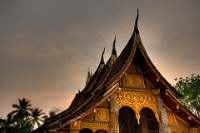
Wat Xieng Thong (Golden City Temple)
Situated at the tip of Luang Prabang's peninsula, the Golden City Temple (Wat Xieng Thong) is the country's most enchanting monastery and perhaps its most talked-about tourist attr…
Wat Xieng Thong (Golden City Temple)
Situated at the tip of Luang Prabang's peninsula, the Golden City Temple (Wat Xieng Thong) is the country's most enchanting monastery and perhaps its most talked-about tourist attraction. Its grandest feature may be the graceful, sweeping tiled roof of its main temple, though the stencilled gold designs on its walls are marvellous too. At the rear, visitors will find a splendid coloured-glass mosaic illustrating the 'tree of life'. The compound garden's peaceful atmosphere features several shelters, which house rare Buddha images and the gilded royal funerary carriage. If tourists can only explore one of the country's monasteries, it should be Wat Xieng Thong. Evenings see the light reflect beautifully off the glass and gold of the walls, while the monks are called into prayer by drums.
Plain of Jars (Phonsavan)
Located in the Xieng Khouang Plateau of Northern Laos, the mysterious Plain of Jars is an unusual sight and a must-see attraction. Visitors will find hundreds of huge stone jars sc…
Plain of Jars (Phonsavan)
Located in the Xieng Khouang Plateau of Northern Laos, the mysterious Plain of Jars is an unusual sight and a must-see attraction. Visitors will find hundreds of huge stone jars scattered about the landscape, some weighing as much as six tonnes and measuring around six feet in length. They're believed to be over 2,000 years old, though their origin and original function remain unknown. One story claims they were made to ferment rice wine to celebrate a victorious battle against a wicked chieftain in the 6th century. Others see them as sarcophagi or funerary urns. The jars are clustered into 90 groups, with Thong Hai Hin being the largest and most easily accessible site. Only Sites 1, 2 and 3 are open to visitors, as unexploded mines from the war lie around the other locations.
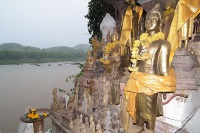
Pak Ou Caves
The Pak Ou Caves lie about two hours from Luang Prabang and are only accessible via a scenic boat trip. The lower and upper caves contain an impressive collection of mostly wooden …
Pak Ou Caves
The Pak Ou Caves lie about two hours from Luang Prabang and are only accessible via a scenic boat trip. The lower and upper caves contain an impressive collection of mostly wooden Buddha statues, which locals and pilgrims have assembled over the centuries. Hundreds of pilgrims journey to the caves every year, adding new statues to the gallery. The collection contains some unusual specimens, many of which are hard to reach. Visitors will need a flashlight to climb the stairs leading to the upper cave. The lower cave is visible from the river. Photos are permitted and visitors often light candles as tributes.
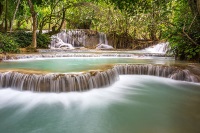
Kuang Si Falls
Tourists frequently rate the multi-tiered Kuang Si Falls as the top attraction in Luang Prabang. The serene location sees turquoise-green water tumble over a series of limestone te…
Kuang Si Falls
Tourists frequently rate the multi-tiered Kuang Si Falls as the top attraction in Luang Prabang. The serene location sees turquoise-green water tumble over a series of limestone terraces and collect in lovely pools, all of which are surrounded by lush greenery. Walkways lead around the base and to the summit, and visitors will find many places to picnic. The swimming is glorious, with rocks, branches and rope swings providing fun ways to enter the water. Given their natural splendour, it's no surprise that the falls get crowded. Travellers should visit as early as possible to fully appreciate the location and take good photographs. The falls are about 18 miles (29km) south of Luang Prabang.
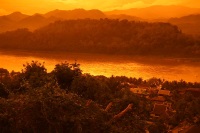
Phou Si
Phou Si is a hill near the confluence of the Khan and Mekong rivers, home to several caves, Buddha images and spectacular views of Luang Prabang. Visitors will find the city's olde…
Phou Si
Phou Si is a hill near the confluence of the Khan and Mekong rivers, home to several caves, Buddha images and spectacular views of Luang Prabang. Visitors will find the city's oldest temples on the lower slopes, but the area's most prized structure is the golden stupa of That Chomsi. It has become a symbol of Luang Prabang's spiritual significance to Laos. Travellers reach the stupa by climbing 300 steps and passing various temples and shady trees along the way. Some of the most interesting Buddha statues can be found via the back entrance. Climbing up one way and down the other would allow visitors to appreciate all the hill's sights and views, with some travellers visiting the night market, which they'll find in front of the Old Palace at the foot of Phou Si.



